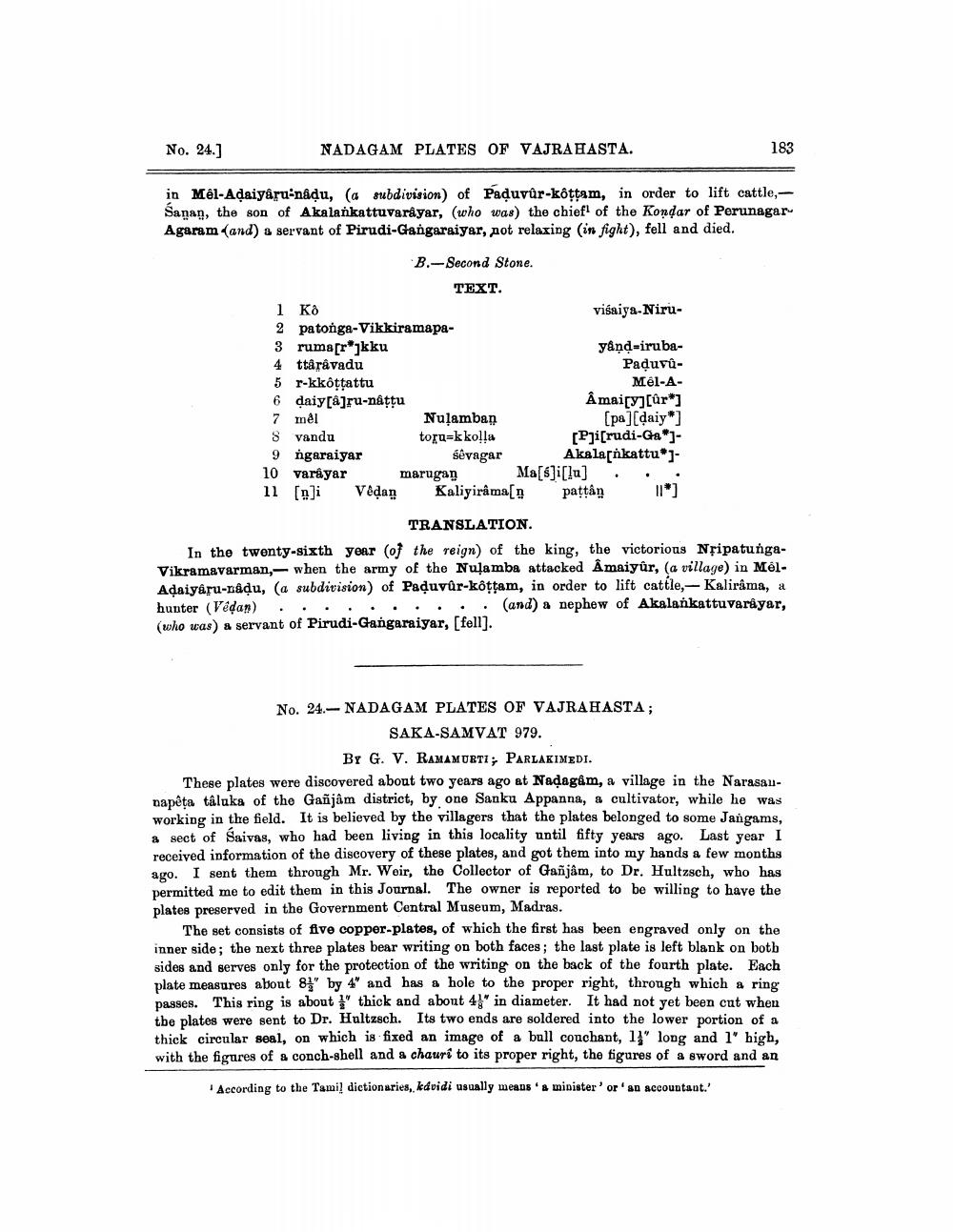________________
No. 24.]
NADAGAM PLATES OF VAJRAHASTA.
183
in Mêl-Adaiyâru:nádu, (a subdivision of Paduvûr-kottam, in order to lift cattle, Sanan, the son of Akalankattuvarayar, (who was the chief of the Kondar of Perunagar Agaram (and) & servant of Pirudi-Gangaraiyar, pot relaxing (in fight), fell and died.
B.-Second Stone.
TEXT. 1 Ko
visaiya-Niru2 patonga-Vikkiramapa3 ruma[r]kku
yånd-iruba4 ttåråvadu
Paduvu5 r-kkottattu
Mél-A6 daiy[&]ru-nåttu
Åmai[y][ur*] 7 mei Nulamban
[pa][daiy*] S vandu toru=kkolla
[P]i[rudi-Ga *9 ngaraiyar
śêvagar
Akalasńkattu*]10 varayar marugan Ma[s]i[lu] . . . 11 [n]i Vedan
Aaliyiraman Kaliyirâma[
pattân 1]
TRANSLATION In the twenty-sixth year of the reign) of the king, the victorious NřipatungaVikramavarman, when the army of the Nulamba attacked Amaiyur, (a village) in MélAdaiyâru-nadu, (a subdivision of Paduvûr-kottam, in order to lift cattle,- Kalirâma, a hunter (Vedan) . . . . . . . . . . (and) a nephew of Akalankattuvarayar, (who was a servant of Pirudi-Gangaraiyar, (fell].
No. 24.- NADAGAM PLATES OF VAJRAHASTA;
SAKA-SAMVAT 979.
By G. V. RAMAMURTI; PARLAKIMEDI. These plates were discovered about two years ago at Nadagam, a village in the Narasaunapêta tâluks of the Gañâm district, by one Sanku Appanna, & cultivator, while he was working in the field. It is believed by the villagers that the plates belonged to some Jangams, a sect of Saivas, who had been living in this locality until fifty years ago. Last year I received information of the discovery of these plates, and got them into my hands a few months ago. I sent them through Mr. Weir, the Collector of Gañjâm, to Dr. Hultzsch, who has permitted me to edit them in this Journal. The owner is reported to be willing to have the plates preserved in the Government Central Museum, Madras.
The set consists of five copper-plates, of which the first has been engraved only on the inner side; the next three plates bear writing on both faces; the last plate is left blank on both sides and serves only for the protection of the writing on the back of the fourth plate. Each plate measures about 8}" by 4" and has a hole to the proper right, through which a ring passes. This ring is about " thick and about 4in diameter. It had not yet been cut when tbe plates were sent to Dr. Hultzsch. Its two ends are soldered into the lower portion of a thick circular seal, on which is fixed an image of a bull couchant, 11" long and l' high, with the figures of a conch-shell and a chauri to its proper right, the figures of a sword and an
According to the Tamil dictionaries, kávidi usually means 's minister' or an accountant.'




